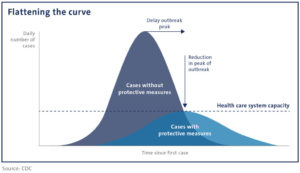What exactly is flattening the curve and how can I help?
The terms “social distancing” and “flattening the curve” were terms few of us had ever heard in early 2020, much less used. If you have been tuned in to the news and media recently, they have become the new buzz words. When it comes to healthcare, what do these words mean?
Social Distancing
Public health professionals not just encouraged social distancing to help reduce the spread of the COVID-19 virus, they also mandated it by closing restaurants, schools, and putting a cap on large gatherings. This meant:
- Outside of work, stay home, and avoid contact outside your immediate family.
- Avoid crowded places and stores, limit your public activities
- When you must go out, keep at least 6 feet between you and others.
UPDATE: Thankfully, our communities took the above warnings seriously and were able to make a real difference in the spread of COVID-19 in Georgia. Hospitals and state officials were given time to prepare and were able to both handle the initial rush of COVID-19 positive patients as well as attain necessary protective equipment for its caregivers. The abovementioned restrictions were lifted early May and the Georgia economy has begun to slowly reopen.
The Curve
With the help of our community leaders, Coffee County took measures early in the crisis like closing schools. We knew that the sooner we could help slow the growth of the “curve,” the better our community would fare.
So what exactly is the curve? It refers to the projected number of people who will contract COVID-19 over a period of time.
The first and dramatic curve you see illustrated in these graphs shows the number of projected cases and time with no precautions taken. You can see the number of infections spikes hard and fast. The line drawn parallel to the x-axis of the graph illustrates our country’s healthcare capacity.
The first curve clearly shows without any precautions, our healthcare system will be overwhelmed and quickly, with cases skyrocketing within weeks. The second curve, which stays below that healthcare capacity line, is what the number of infections could look like over time with effective social distancing. This curve grows more slowly in the number of infected people, meaning less strain on our healthcare system and more time to react.

How does “flattening the curve” help our healthcare system?
One of the primary concerns with the spread of this virus is the stress placed on our healthcare system. Hospital staffing, supplies, equipment, and available beds are all resources that will inevitably be strained. If too many people become sick at the same time, there simply will not be enough medical resources available to treat everyone at once.
Simply put: the more people we as a society can keep from getting the virus, the fewer people need hospitalization, the less the strain on our healthcare systems.
This is also critical so our hospitals can still provide emergency care for others in our community, like those needing care for stroke or a heart attack. Medical emergencies will still happen and everyone deserves a medical system that can help them in their time of need.
So, by practicing social distancing and helping to “flatten the curve,” we’re not only helping those most at risk for COVID-19 complications, we’re ensuring others in our community can get care when they need it most. Although we managed to flatten the curve here in Coffee County this Spring, we must remain vigilant in our efforts to ensure we do not have further community spread. COVID-19 is still spreading, so we must all continue to do our part and take the proper precautions to keep ourselves and our families safe. Wearing a face mask when out in public, practicing distancing measures when around those not in our immediate family, and washing our hands often and thoroughly when we are around others or out in public will ensure we are holding the curve.